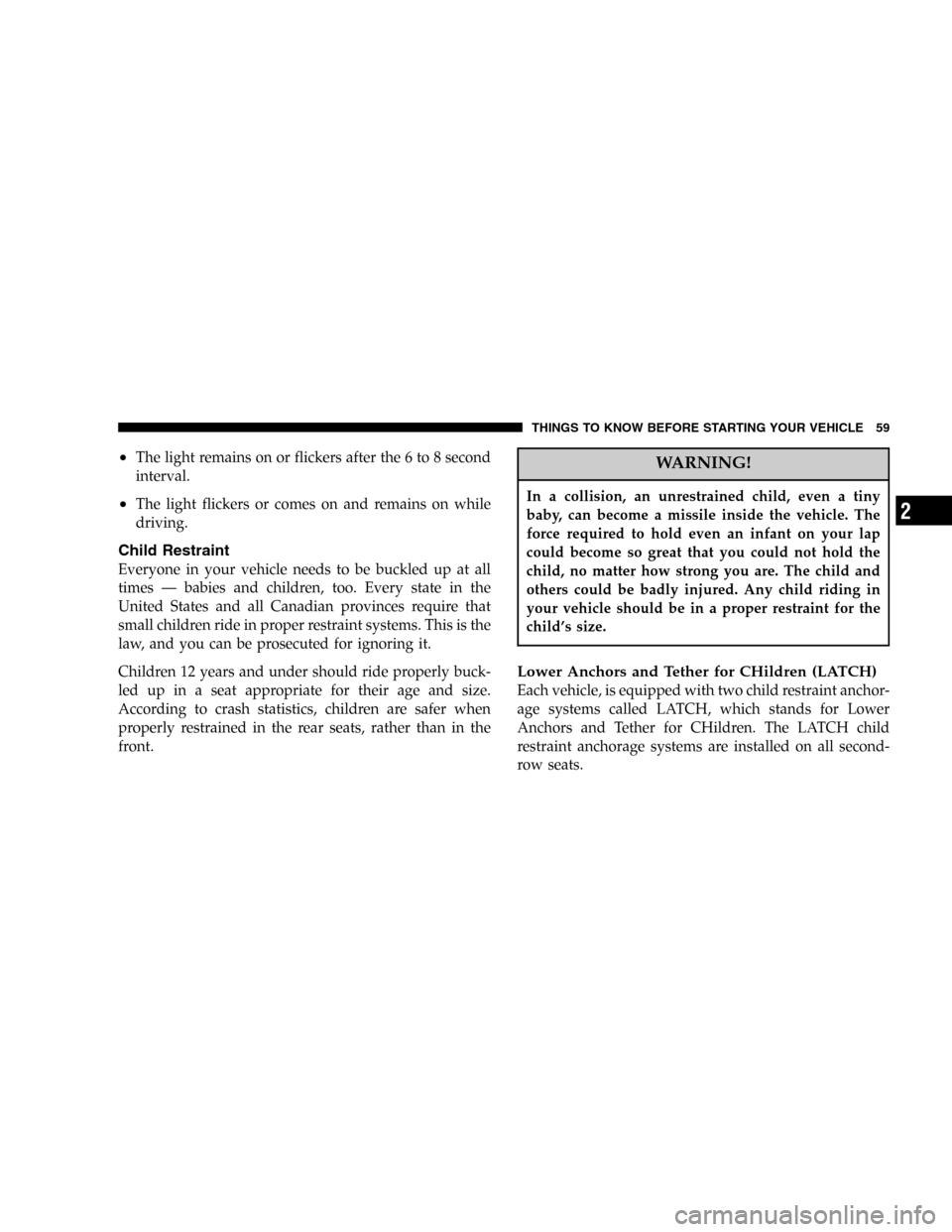Page 10 of 420

▫To Turn Off“Flash Lights On Lock/Unlock”...23
▫General Information....................23
▫Transmitter Battery Service...............24
�Vehicle Theft Alarm......................25
�Liftgate...............................27
▫Power Liftgate—If Equipped.............28
�Windows.............................30
▫Power Windows.......................30
�Occupant Restraints......................32
▫Lap/Shoulder Belts.....................33
▫Lap/Shoulder Belt Untwisting Procedure.....39
▫Seat Belt Pretensioners...................41▫Enhanced Driver Seat Belt Reminder System
(BeltAlert)...........................41
▫Seat Belts And Pregnant Women............42
▫Seat Belt Extender......................43
▫Driver And Front Passenger Supplemental
Restraint System - Airbag................44
▫Child Restraint........................59
�Engine Break-In Recommendations...........67
�Safety Tips............................68
▫Exhaust Gas..........................68
▫Safety Checks You Should Make Inside The
Vehicle..............................68
▫Periodic Safety Checks You Should Make
Outside The Vehicle....................69
10 THINGS TO KNOW BEFORE STARTING YOUR VEHICLE
Page 32 of 420

windows down, or the sunroof (if equipped) in certain
open or partially open positions. This is a normal occur-
rence and can be minimized. If the buffeting occurs with
the rear windows open, open the front and rear windows
together to minimize the buffeting. If the buffeting occurs
with the sunroof open, adjust the sunroof opening to
minimize the buffeting.
OCCUPANT RESTRAINTS
Some of the most important safety features in your
vehicle are the restraint systems. These include the front
and rear seat belts for the driver and all passengers, front
airbags for both the driver and front passenger, and if
equipped, left and right window bags for the driver and
passengers seated next to a window and a driver inflat-
able knee blocker. If you will be carrying children too
small for adult-size seat belts, your seat belts or the
LATCH feature (refer to the Child Restraint section in this
manual), can be used to hold infant and child restraint
systems.If your vehicle is equipped with the Occupant Classifi-
cation System (OCS) there will be a Passenger Airbag
Disabled (PAD) Indicator Light located on the center of
the instrument panel.
Passenger Airbag Disabled Light
32 THINGS TO KNOW BEFORE STARTING YOUR VEHICLE
Page 47 of 420

Here are some simple steps you can take to minimize the
risk of harm from a deploying airbag.
1.Children 12 years old and under should always ride
buckled up in a rear seat.
Infants in rear facing child restraints shouldNEVERride
in the front seat of a vehicle with a passenger front airbag.
An airbag deployment can cause severe injury or death to
infants in that position.
Children that are not big enough to properly wear the
vehicle seat belt (refer to section on Child Restraint)
should be secured in the rear seat, in a child restraint or
belt-positioning booster seat appropriate for the size and
age of the child. Older children who do not use a child
restraint or belt-positioning booster seat should ride
properly buckled up in the rear seat. Never allow chil-
dren to slide the shoulder belt behind them or under their
arm.If a child from 1 to 12 years old must ride in the front
passenger seat because the vehicle is crowded, move the
seat as far back as possible, and use the proper child
restraint. Refer to the section on Child Restraint.
You should read the instructions provided with your
child restraint to make sure that you are using it properly.
2.All occupants should wear their lap and shoulder
belts properly.
3.The driver and front passenger seats should be
moved back as far as practical to allow the front airbags
room to inflate.
4.If your vehicle has left and right window bags, do
not lean against the door, airbags will inflate forcefully
into the space between you and the door.
THINGS TO KNOW BEFORE STARTING YOUR VEHICLE 47
2
Page 54 of 420

For almost all sizes of properly seated adults, the airbag
will be enabled in the event of a collision. For small
teenagers and some small adults, depending on size, the
airbag may or may not be enabled in the event of a
collision. Both drivers and passengers should always use
the PAD indicator light as an indication if the front
passenger is properly positioned or not. If the PAD
indicator light comes on when an adult is in the passen-
ger seat, have the passenger re-position themselves in the
seat until the light goes out.
Remember, if the PAD indicator light is illuminated the
passenger front airbag will not inflate. For properly
installed child restraint systems and children properly
seated on the front passenger seat, the airbag will be
disabled. If at all possible, place children 12 years and
younger in a back seat.
•TheOccupant Classification Module (OCM)is lo-
cated beneath the front passenger seat. The OCMclassifies the occupant into one of three size categories
based on the input from the Bladder Assembly and
Belt Tension Sensor. The size categories include empty,
child, and adult. The OCM sends the Occupant Clas-
sification to the ORC to identify if a front passenger
airbag is allowed. If a fault is present, the AIRBAG
warning light is illuminated.
•ThePassenger Airbag Disabled (PAD) Indicator
Lightindicates to the driver and passenger when the
airbag is turned OFF in the presence of a properly
seated occupant. When the PAD indicator light is
illuminated, the airbag is OFF. Also, when the Occu-
pant Classification System (OCS) detects either an
empty seat of a weight less than the predetermined
occupant threshold, the ORC will not illuminate the
PAD indicator light even though the airbag is turned
off. When the OCS detects an adult the PAD indicator
light will be off, and the airbag will be enabled.
54 THINGS TO KNOW BEFORE STARTING YOUR VEHICLE
Page 59 of 420

•The light remains on or flickers after the 6 to 8 second
interval.
•The light flickers or comes on and remains on while
driving.
Child Restraint
Everyone in your vehicle needs to be buckled up at all
times—babies and children, too. Every state in the
United States and all Canadian provinces require that
small children ride in proper restraint systems. This is the
law, and you can be prosecuted for ignoring it.
Children 12 years and under should ride properly buck-
led up in a seat appropriate for their age and size.
According to crash statistics, children are safer when
properly restrained in the rear seats, rather than in the
front.
WARNING!
In a collision, an unrestrained child, even a tiny
baby, can become a missile inside the vehicle. The
force required to hold even an infant on your lap
could become so great that you could not hold the
child, no matter how strong you are. The child and
others could be badly injured. Any child riding in
your vehicle should be in a proper restraint for the
child’s size.
Lower Anchors and Tether for CHildren (LATCH)
Each vehicle, is equipped with two child restraint anchor-
age systems called LATCH, which stands for Lower
Anchors and Tether for CHildren. The LATCH child
restraint anchorage systems are installed on all second-
row seats.
THINGS TO KNOW BEFORE STARTING YOUR VEHICLE 59
2
Page 60 of 420
The lower anchor bars of the LATCH System are located
where the seat back meets the seat cushion.
The tether anchors are located on the rear surface of the
seat.Child restraint systems designed to be compatible with
the vehicles LATCH System are now available. LATCH
child restraints make installation into the vehicle simple
and convenient.
Latch Anchorages
Tether Strap Mounting
60 THINGS TO KNOW BEFORE STARTING YOUR VEHICLE
Page 61 of 420
When using the LATCH System, always follow the child
restraint manufactures installation instructions.
NOTE:If your child restraint seat is not LATCH com-
patible, install the restraint using the vehicle seat belts.
Tether Anchors
There are tether strap anchorages behind all second row
seating positions and if equipped the driver’s side third
row seating position. The tether anchors are located in
the rear surface of the seat. When using the tether
anchorages in the second row seating position, ensure
that the strap is routed over the top of the seatback and
under the head restraint between the head restraint posts.
Second Row Tether
THINGS TO KNOW BEFORE STARTING YOUR VEHICLE 61
2
Page 62 of 420
When the tether anchorage is used in the third row
seating position, the strap should be positioned straight
over the top of the seatback.Infants and Children
There are different sizes and types of restraints for
children from newborn size to the child almost large
enough for an adult safety belt. Always check the child
seat owner’s manual to ensure you have the right seat for
your child. Use the restraint that is correct for your child:
•Safety experts recommend that children ride
rearward-facing in the vehicle until they are at least
one year old and weigh at least 9 kg (20 lbs). Two types
of child restraints can be used rearward-facing: infant
carriers and�convertible�child seats. Both types of
child restraints are held in the vehicle by the lap/
shoulder belt or the LATCH child restraint anchorage
system. Refer to“Lower Anchors and Tether for CHil-
dren (LATCH)”in this section.
Third Row Tether Strap Routing
62 THINGS TO KNOW BEFORE STARTING YOUR VEHICLE